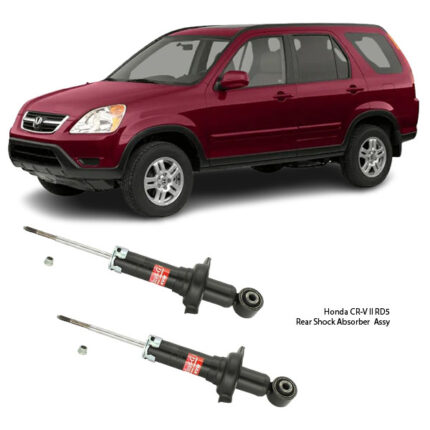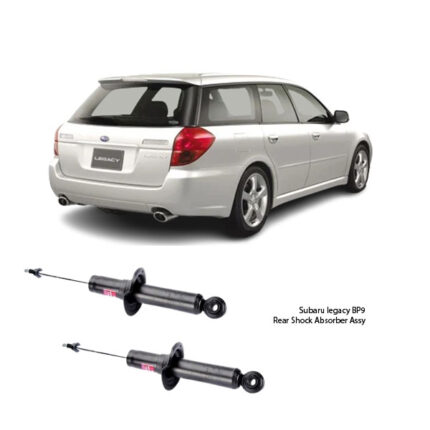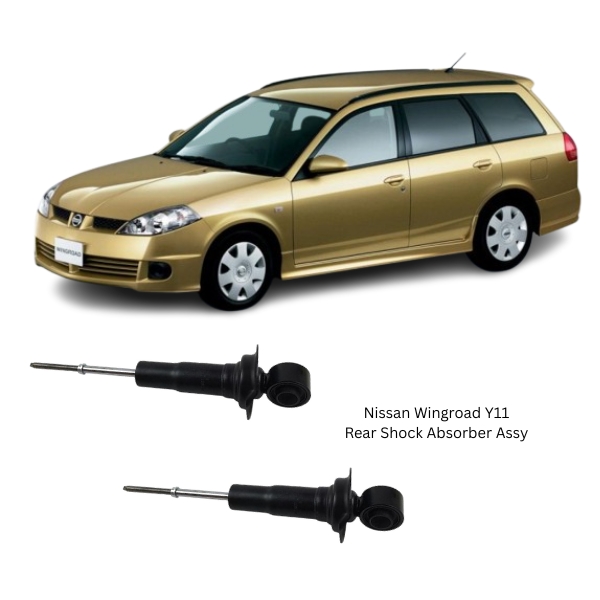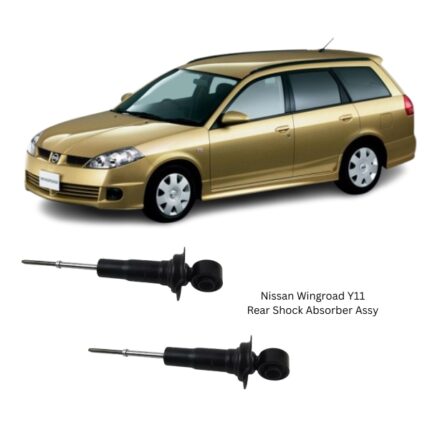Get Nissan Wingroad Y11 Rear Shock Absorber Assy 341357 in Kenya
The Rear Shock Absorber Assembly is a vital component of the suspension system in a vehicle, tasked with maintaining ride comfort, controlling suspension motion, and ensuring safety during driving. This assembly works by dampening the oscillations of the vehicle’s rear springs and controlling unwanted motion that can be triggered by road imperfections, cornering, braking, or acceleration. Its function is critical to vehicle handling, stability, and tire wear.
1. Function and Purpose
The primary function of a rear shock absorber is to control the vertical movement of the rear wheels. It converts the kinetic energy from road bumps into heat energy through hydraulic fluid movement within the shock body. Without this damping effect, the vehicle would bounce uncontrollably, reducing road grip and compromising both comfort and safety.
The shock absorber assembly:
-
Minimizes body roll and sway during cornering
-
Reduces brake dive and acceleration squat
-
Improves tire-to-road contact
-
Maintains rear wheel alignment and road tracking
-
Assists in load control and weight distribution
2. Construction and Components
A typical rear shock absorber assembly consists of the following components:
-
Piston and Rod: The piston is attached to a rod that moves within the shock body. As the suspension compresses or rebounds, the piston moves through oil inside the shock, controlling motion.
-
Cylinder (Shock Body): The cylindrical housing that holds hydraulic fluid. It may also incorporate a secondary chamber for gas in gas-charged shocks.
-
Hydraulic Fluid: This fluid is essential for damping. As the piston moves, fluid passes through valves and orifices, absorbing energy.
-
Valving Mechanism: These internal valves control the rate of fluid flow, determining the shock’s resistance characteristics. Variable valving provides a balance between comfort and control.
-
Dust Boot and Bump Stop: Protects the internal components from debris and cushions the shock during full compression.
-
Mounting Hardware: Upper and lower mounts (often rubber or urethane bushings) connect the shock to the vehicle’s frame and axle or control arms. These must be durable to withstand constant movement and road stress.
Some vehicles use twin-tube shocks, while others may utilize mono-tube or even coilover shock absorbers, where the spring is integrated with the shock absorber. Advanced systems may feature electronically adjustable dampers for dynamic ride tuning.
3. Operation and Damping
Shock absorbers operate on the principle of fluid dynamics. When the rear wheel hits a bump, the suspension compresses, forcing the shock piston to move within the cylinder. As it moves, hydraulic fluid is pushed through the shock’s internal valves. This restricts motion, effectively dampening the bounce and controlling spring energy.
There are two types of damping:
-
Compression Damping: Controls how the shock responds when compressed, like when hitting a bump.
-
Rebound Damping: Regulates how fast the shock returns to its normal position after compression.
Proper tuning between compression and rebound damping ensures a balanced, stable ride and effective suspension response.
4. Materials and Durability
Rear shock absorber assemblies are designed to withstand harsh conditions, including dirt, water, extreme temperatures, and corrosive environments. Common materials include:
-
Hardened steel or aluminum for the shock body and piston rod
-
Nitrile or urethane for seals and bushings
-
High-performance hydraulic oil with anti-foaming and anti-wear additives
Gas-charged shocks include a sealed chamber filled with nitrogen gas, which helps reduce oil foaming, improves response time, and enhances performance under continuous use.
5. Installation and Positioning
Rear shock absorbers are typically mounted vertically or at a slight angle between the rear axle (or trailing arm) and the vehicle’s chassis. Each vehicle has a specific mounting design, either eye-to-eye, pin-to-eye, or clevis-style configurations. Some vehicles use a single shock per wheel, while others—especially in performance or off-road setups—may use dual shocks for added control.
Proper installation ensures the shock absorber can move freely through its full range of motion without binding or bottoming out. Torque specs must be followed for mounting bolts to avoid premature wear or failure.
6. Signs of Worn Rear Shock Absorbers
As a critical suspension component, shock absorbers naturally wear out over time due to constant movement and exposure to elements. Signs of wear include:
-
Excessive bouncing after bumps
-
Nose diving or squatting during braking or acceleration
-
Leaking hydraulic fluid around the shock body
-
Uneven tire wear
-
Poor rear-end stability during turns
-
Clunking or rattling noises from the rear suspension
When any of these symptoms are observed, inspection and potential replacement are necessary to maintain vehicle safety and performance.
7. Maintenance and Inspection
Although shock absorbers are generally maintenance-free, routine inspections help extend their service life:
-
Visually inspect for leaks, corrosion, or physical damage
-
Check for worn or damaged bushings
-
Test damping action by pushing down on the rear of the vehicle and observing rebound
-
Listen for unusual noises when driving over rough terrain
Replacing rear shocks in pairs (left and right) ensures balanced handling and even performance.
8. Benefits of a Properly Functioning Rear Shock Absorber Assy
-
Improved Safety: Better braking efficiency and control, especially in emergency maneuvers.
-
Enhanced Comfort: Smooth and stable ride over bumps and rough roads.
-
Prolonged Tire Life: Reduces irregular tire wear caused by poor damping.
-
Optimal Load Control: Supports consistent vehicle behavior even with variable passenger or cargo loads.
-
Improved Fuel Economy: Stable suspension minimizes rolling resistance and improves vehicle aerodynamics.
9. Common Types of Rear Shock Absorbers
-
Standard Hydraulic Shocks: Offer reliable damping for everyday driving.
-
Gas-Charged Shocks: Provide enhanced performance and quicker response.
-
Adjustable Shocks: Allow tuning of compression and rebound characteristics.
-
Heavy-Duty Shocks: Built for off-road, towing, or high-load applications.
Each type serves a specific driving purpose and should be selected based on usage and driving conditions.
Follow us on Facebook for more parts.





Reviews
Clear filtersThere are no reviews yet.